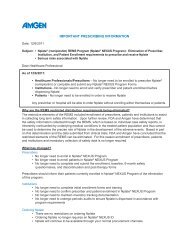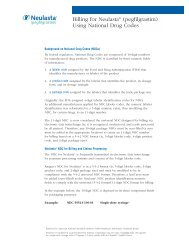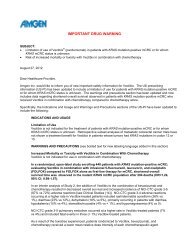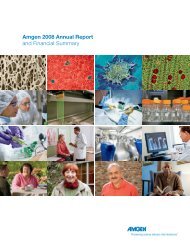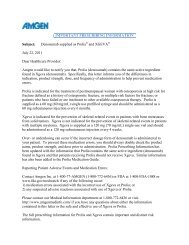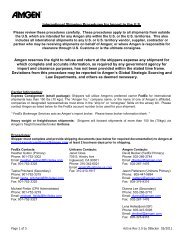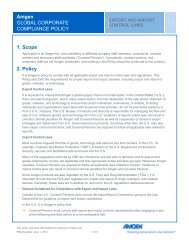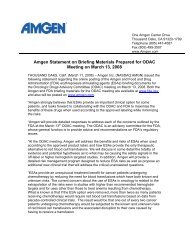Re: National Coverage Analysis for Erythropoiesis ... - Amgen
Re: National Coverage Analysis for Erythropoiesis ... - Amgen
Re: National Coverage Analysis for Erythropoiesis ... - Amgen
You also want an ePaper? Increase the reach of your titles
YUMPU automatically turns print PDFs into web optimized ePapers that Google loves.
<strong>Amgen</strong> Comments on CAG-00413N<br />
July 16, 2010<br />
Page 4 of 15<br />
management required <strong>for</strong> their treatment[1, 2]. Most notable among these differences is that<br />
dialysis patients depend on regular dialysis treatments to sustain life and have profound anemia<br />
that is nearly universal in the absence of ESA treatment, due to the extent of native<br />
erythropoietin deficiency and the continuous blood loss from the dialysis procedure. As a<br />
consequence, hemoglobin levels in dialysis patients are quite low in the absence of therapy,<br />
contributing to a poorer quality of life and more limited ability to function. Prior to the<br />
introduction of ESA therapy, the majority of dialysis patients were maintained with transfusions<br />
and had Hb levels < 8 g/dL[3, 4], a level associated with anemia symptoms that would be<br />
unacceptable today. Dialysis patients have routinely expressed their belief that EPOGEN ® has<br />
the ability to significantly improve their health and overall quality of life[5].<br />
While the presence of anemia in dialysis patients is virtually universal, CKD-NOD patients are<br />
more heterogeneous; there is a greater range of renal dysfunction, erythropoietin levels and<br />
degree of anemia. Severe anemia and the increased risk of transfusions are more commonly<br />
present among patients with more advanced kidney disease. For CKD-NOD patients, ESAs<br />
offer clinical benefits in patients <strong>for</strong> whom transfusion avoidance is a meaningful clinical<br />
outcome.<br />
Thus, the agency should separately consider the available evidence regarding the effects of<br />
ESAs on health outcomes <strong>for</strong> dialysis patients and CKD-NOD patients.<br />
B. Transfusions carry significant risks specific to the CKD patient population and<br />
can delay or preclude kidney transplantation, the preferred ESRD treatment of<br />
choice<br />
RBC transfusions are only transiently effective in a population that is chronically unable to<br />
produce sufficient RBCs[6]. Furthermore, RBC transfusions carry a range of well-known risks<br />
including transfusion reactions, transmission of viral and other infectious agents. Although less<br />
common in the general population, the risks of volume and potassium overload are particularly<br />
problematic <strong>for</strong> CKD patients because these patients are unable to adequately regulate volume<br />
and electrolytes due to decreased or absent kidney function. Thus CKD patients who are<br />
transfused may experience acute volume and potassium overload requiring hospitalization[7-<br />
11]. The most significant long-term risk related to transfusions is the potential <strong>for</strong> allosensitization<br />
to <strong>for</strong>eign antigens [2, 12, 13]; the development of such antibodies can delay or<br />
preclude kidney transplantation and impair the function of kidney transplants that do occur[2,<br />
14]. Transplant is the preferred therapy <strong>for</strong> ESRD because of benefits such as a 50 percent<br />
higher five-year survival and one-third the cost of treatment[2]. Ef<strong>for</strong>ts to minimize transfusions<br />
and their potential consequences should be encouraged through Medicare coverage policy to<br />
preserve and enhance successful renal transplantation as an outcome.



